Robb Cadigan's Blog
March 19, 2015
THANKS FOR ALL THE SUPPORT FOR MY DEBUT NOVEL! THE BLOG IS ON HIATUS WHILE I WORK ON THE NEXT BOOK.
In the meantime, take a moment to check out all the great Q&A interviews here on the site. Fun conversations with creatives like Laura Lippman, Dennis Lehane, Reed Farrel Coleman, Megan Abbott, George Pelecanos, Brad Meltzer, Duane Swierczynski, Dennis Tafoya, Kristen Ellis-Henderson, and many others!
Published on March 19, 2015 11:06
September 9, 2014
GET "THE DROP" ON DENNIS LEHANE AS WE TALK CREATIVITY AND HIS BEST %$#&ing writing advice
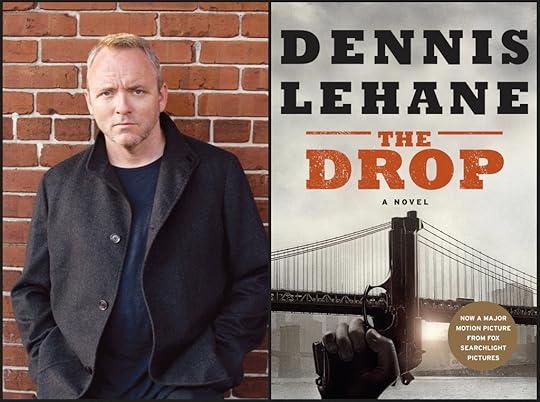 Dennis Lehane's terrific story, THE DROP, arrives in bookstores and movie theaters this week. Pick up the novel (based on Dennis's short story, "Animal Rescue") and go check out the motion picture, starring Tom Hardy, Noomi Rapace, and James Galdolfini (in his final role). Dennis wrote the screenplay, which details "a robbery gone awry and an investigation that digs deep into the neighborhood's past where friends, families, and foes all work together to make a living -- no matter the cost." I loved the original short story and was lucky enough to get my hands on a preview copy of the novel. I'll be first in line this weekend to see the film. Great stuff as always from the master, Dennis Lehane.
Dennis Lehane's terrific story, THE DROP, arrives in bookstores and movie theaters this week. Pick up the novel (based on Dennis's short story, "Animal Rescue") and go check out the motion picture, starring Tom Hardy, Noomi Rapace, and James Galdolfini (in his final role). Dennis wrote the screenplay, which details "a robbery gone awry and an investigation that digs deep into the neighborhood's past where friends, families, and foes all work together to make a living -- no matter the cost." I loved the original short story and was lucky enough to get my hands on a preview copy of the novel. I'll be first in line this weekend to see the film. Great stuff as always from the master, Dennis Lehane. With all this activity this week for Lehane fans, it seems like the perfect time to revisit the Q&A Dennis did with me a while back. He talks about fiction and the creative life, and gives some words of wisdom that hang over my own writing desk (because I chickened out on getting them as a tattoo). Go here to read the Q&A. And get in on THE DROP this week!
Published on September 09, 2014 10:59
September 2, 2014
MEET RON GILES, AUTHOR. A Q&A WITH A CREATIVE SOUL WHO BRINGS VAST LIFE EXPERIENCES TO HIS FICTION
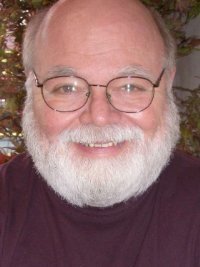 I first met Ron Giles some twenty-five years ago, when our corporate career paths crossed at QVC, a then-fledgling shopping channel/electronic retailer. Part of the founding class of QVC, Ron was an entrepreneurial television veteran, whose many innovations are still used today by programs selling products on TV. Working with Ron during those years, I always appreciated his leadership, gentlemanly demeanor, and creativity. He was a kindred spirit.
I first met Ron Giles some twenty-five years ago, when our corporate career paths crossed at QVC, a then-fledgling shopping channel/electronic retailer. Part of the founding class of QVC, Ron was an entrepreneurial television veteran, whose many innovations are still used today by programs selling products on TV. Working with Ron during those years, I always appreciated his leadership, gentlemanly demeanor, and creativity. He was a kindred spirit. After he retired from television, Ron turned his attention to a new frontier: writing for print. His first effort, On Harrisonville Avenue, was an amusing memoir about his own youth in a mill town on the Ohio River. His first novel, Cottonwood Pass, delved into the world of suspense and global politics with a story set in Colorado. I particularly enjoyed the imagination behind his third book, Great Heats, historic fiction set 1,000 years ago among the mounds and earthworks of what is now Southern Ohio.
Ron's most recent novel, Locusts and Wild Honey, is a captivating novel of interwoven short stories, featuring a ghost, a witch, and a curse that follows generations of the Porter family. Something wicked this way comes and Ron handles it all with skill and insight.
Finally, I'm thrilled to learn that Ron's short story, "The Friday Night Dance," will be included in Every River on Earth: Writing from Appalachian Ohio. Edited by Neil Carpathios, this anthology of poetry and stories features the work of forty Ohio writers, including Donald Ray Pollock. Watch for it in January 2015. (Another Ron Giles short story, "The Prey," is featured in Chester County Fiction, the well-received anthology from Oermead Press.)
A teacher and historian. A television veteran and interactive-TV pioneer. A singer and member of The Hymn Society. A writer. Ron Giles brings his talents and interests to his fiction. And I'm so glad he took the time to visit the blog today with this fascinating Q&A about the creative life. Hi Ron, thanks for being here. Tell us: when did you know you wanted to be a writer?
The decision to try writing a book came to me late in life—in 2007. Retirement had been forced on me in 2001 with the 9/11 attacks. After that tragedy, corporations retrenched and became conservative with their spending, not using Television Consultants as they once had. With no work on the horizon, my wife and I began traveling in the US, and while in Northern California, I picked up a John Steinbeck novella, Cannery Row, at the Monterrey Airport. Steinbeck’s writing had spoken to me as a college student and years later, I fell gladly and comfortably back into his characterizations, descriptions, and dialogue woven around a good story.
While reading Cannery Row, at age 65, I decided to try my hand at writing a book.
I make the book distinction because during my 35-year television career, I had written many intros/outros, commercials and public service announcements—short form, compact communications—and with our church program, "Hymns and Their Stories"—I was writing three-minute histories of a hymn’s creation—but I had never, on my own, set out to write something with characters and a plot that takes place over days, weeks, or years. I brushed up on the principles of writing and took a Great Courses study from the Iowa Writers’ Workshop, sat down and began. The book was to be a murder mystery, set in my hometown during the 1950s. The planning, flexibility, and fluidity necessary to manage writing such a plot quickly revealed itself and I threw that idea away and settled instead on writing a memoir set in 1955 when I was thirteen.
Who or what inspired you as a kid or teenager?
I found the life of Christ an engrossing and inspiring story then and still do today. The rapid move from being acclaimed as the Messiah to being executed in a horrible way was tragic. Yet the grace with which Christ faced the inevitable was stirring and admirable. I still marvel at it.
As a twelve year old, when I began reading literature, I started with Thomas Hardy’s Tess of the d’Urbervilles. I was reading it over an RC Cola at the local restaurant hangout, when a town character, Doug, approached me and asked if I had read any American authors. After thinking about it, and answering negatively, he led me outside to his car, a 1948 Hudson, in which some people believed he lived, sleeping on the front seat, because the back seat was taken with his “library” as he called it – hundreds of books, organized in some way that only he understood, with cardboard boxes stacked on top of each other, bulging with paperbacks and hard covers . He reached a long arm in and pulled out a hardback edition of The Adventures of Huckleberry Finn by Mark Twain. “Read this,” he commanded. “It will change your life.” I finished the Hardy novel and then read Twain. The clash of the Victorian style with Twain’s vernacular and profane style was glorious, and, Doug was right—the racial and social attitudes confronted by Huck rattled the teenage world I was sure that I understood, until then.
What creative work most recently inspired you?
I recently finished Absence of Mind by Marilynne Robinson—a 130-page exploration of the conflict between science and religion. A novelist with a Pulitzer Prize and a Hemingway Award, she shines her considerable intellect and vocabulary on the place of “mind” in a biological being.
In moments of self-doubt, how do you push through?
Doubt about the path that I have started down, or having written myself into a corner, or not having any words come to me are all things that happen to me. To get out of this, I force myself to write, even though my instinct is to keep my hands away from a keyboard. I might (probably will) throw away what I write during this time, but the act of writing focuses me on what I should be doing, even though the words might be wrong or I spend too many words “telling” the story rather than using dialog to advance the plot.
Have you ever abandoned a creative project?
I have a “whodunit” puzzler synopsis that I set down on two or three pages of paper and then stopped because I had not completely graphed out the twists and turns of the plot; I have never rekindled the desire to return and pick it back up. It involved the discovery of four Homo sapiens skeletons in a lava tube located among the Deccan Traps of India and the suspicious deaths of each explorer on the team who made the discovery. Hmmmm.
Which of your works comes closest to the way you heard/saw it in your head?
My third book, Great Heats, was pretty much how I envisioned it. I had grown up in an area of Ohio where the Adena/Hopewell people from the pre-historic period of this continent left evidence of their life and their art. In my hometown today is a horseshoe-shaped mound that they built 2000 years ago. The rims of the Horseshoe Mound are eight feet high and it is 75 feet long at the “U.” In all the years while growing up that I saw the mounds and their ceremonial pipes, I only saw objects. But one day in 2008, while visiting the Hopewell National Park (it used to be called “Mound City”) in Chillicothe, Ohio, I asked myself about the lives of the people that built the mounds and fashioned the ceremonial objects —their triumphs, their joys, their adversities. It wasn’t long afterwards that an outline emerged.
What was the best creative advice you ever received?
The writing advice that paid dividends and stays with me even today came from my 9th Grade English teacher, Mrs. Campbell. “Be observant,” she said. The way someone speaks or walks or points a crooked finger; the smell of the woods, the way the maple leaves show their silvery underside before a storm, the colors of the sky at dawn; the pictures on the old man’s wall, the drink she always orders, in her one, small closet are only black clothes.
As a singer, the best advice I ever received was that “the text is more important than the note you are singing.” The 1893 poetry of Katharine Lee Bates marries well with the Samuel Ward melody, but the words are what make the melody meaningful:
"O beautiful for spacious skies,
For amber waves of grain,
For purple mountain majesties
Above the fruited plain! America! America!"
My favorite fictional character or hero is ...
James Bond is my favorite. The guy is handsome, witty, knows about guns, cocktails, fast cars, electronic gadgets, and most of all, he is an expert with women—clearly a fictional character.
The last film or TV show I enjoyed was ...
The Monuments Men. The movie has an all-star cast (I confess to being a Bill Murray fan) and I loved that the director (George Clooney) used his father, Nick Clooney, in the final scene as an aged version of the character George Clooney played.
The next book on my reading pile is ...
Dark History of the Popes: Vice, Murder and Corruption in the Vatican by Brenda Ralph Lewis, an author with 25 books out covering an eclectic range of subjects, including poisonous snakes, reptiles, solitaire, the Royals and now the Popes. It’s a progression, no?
The book I really should have read by now is ...
The Bible. I have read selected books but not the whole volume cover-to-cover. I prefer the King James Version (1611). The committee which James I put together were scholars in various languages who were divided further into committees to provide the definitive translation of ancient documents. The translations also had to read well out loud, since most common people could not read for themselves. Before a sub-committee’s work was accepted, it had to be read aloud to the full committee and approved. Even today, the King James Version is musical and it is always a pleasure to read the 400 year old document.
Does The Great American Novel exist (yet)? If so, what is it?
Yes. And there are many of them – The Adventures of Huckleberry Finn, The Great Gatsby, Gone with the Wind, The Grapes of Wrath, To Kill a Mockingbird, The Old Man and the Sea, Blue Highways, and several others that you are probably thinking about now, each born of the era in which they were created while speaking to us today, standing strong as examples of the writer’s craft.
What creative work might we be surprised to find on your shelf, iPod, or DVR?
Outfoxed: Marvin Davis, Barry Diller, Rupert Murdoch and the Inside Story of America's Fourth Television Network by Ben Block. I bought the book after Diane von Furstenberg’s first appearance on QVC, during which I met her friend, Barry Diller, in the Green Room. I meant to read it to check out Diller’s management style and to confirm or dispel stories about him. He was on the prowl then, looking to acquire an interest in something to run. Most thought it was Paramount Motion Pictures, while the whispered rumors in the Boardroom at QVC were that it might be us that he was targeting. I never got around to reading Outfoxed; probably should have read it then— don’t care now.
In addition to writing, how do you express your creativity?
I am blessed to have a solo singing voice and doubly blessed to have married a gifted pianist. (Joan is also very knowledgeable of the rules of grammar, which I regularly violate in the rush and excitement of setting words down on paper, so she is my Senior Editor.) In 1997, we designed “Hymns and Their Stories,” a church program where I tell the story of a familiar hymn’s creation and then we present an interesting musical arrangement of the hymn that mostly involves the congregation, but sometimes is a solo. Now in our 17th year, we have appeared at churches in Ohio, Pennsylvania and New Jersey.
The most difficult thing about the life of a creative is ...
For me, the most problematic part has always been the discipline to sit down and just do it. In my television career, with music, and with writing, a deadline has to crowd in on me to make me stop doing other things and concentrate on the open project. I have a lovely and spacious house, but there are always things calling out to me—paint me, wash me, scrub me, water me, clean me, replace me, sing me, answer me, pay me—so I go to one of several local restaurants with wi-fi, egg whites and an atmosphere where I can work without paying attention to the distractions.
How has your passion for history informed your fiction?
History was my first academic love, and I taught American History at the eighth grade level for three years before changing careers to television production. In my writing, there is always a back-beat of history to the story, whether political, economic, religious or geographic because the characters, in my view, are intertwined with the forces of history. Charles Beard, the influential historian of the first half of the 20th Century was asked if would write a book about the Lessons of History. Beard replied that he didn’t need to write a book because he could summarize the lessons of history in four sentences:
1. Whom the gods would destroy, they first make mad with power.
2. The mills of God grind slowly, but they grind exceedingly fine.
3. The bee fertilizes the flower it robs.
4. When it is dark enough, you can see the stars.
Makes great fodder for characters, plots and storylines, don’t you think?
 Excellent insights from Ronald D. Giles. You can find Ron's most recent novel, Locusts and Wild Honey, along with all of his work, on amazon.com. Watch for his story in Every River on Earth: Writing from Appalachian Ohio in January 2015. And when he's not singing in a church somewhere or writing away on his laptop in a neighborhood restaurant, Ron can be found on Facebook or at his blog. Go discover the rich work of Ronald D. Giles for yourself.
Excellent insights from Ronald D. Giles. You can find Ron's most recent novel, Locusts and Wild Honey, along with all of his work, on amazon.com. Watch for his story in Every River on Earth: Writing from Appalachian Ohio in January 2015. And when he's not singing in a church somewhere or writing away on his laptop in a neighborhood restaurant, Ron can be found on Facebook or at his blog. Go discover the rich work of Ronald D. Giles for yourself.
Published on September 02, 2014 06:21
August 25, 2014
PHOENIXVILLE RISING FEATURED IN POETS & WRITERS' NEW COLUMN, "THE SAVVY SELF-PUBLISHER"
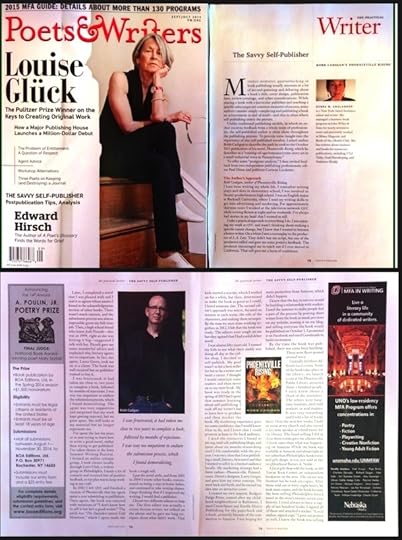 Very honored that POETS & WRITERS magazine introduced their new "The Savvy Self-Publisher" column with a five-page spread on "Robb Cadigan's PHOENIXVILLE RISING." In the interview, I share my journey as a writer and self-publisher and receive some valuable criticism and advice from two publishing-industry professionals. I hope my experiences with my debut novel are helpful to fellow writers.
Very honored that POETS & WRITERS magazine introduced their new "The Savvy Self-Publisher" column with a five-page spread on "Robb Cadigan's PHOENIXVILLE RISING." In the interview, I share my journey as a writer and self-publisher and receive some valuable criticism and advice from two publishing-industry professionals. I hope my experiences with my debut novel are helpful to fellow writers. "The narrative is quite polished and the characters are strongly realized ... all in all, the book itself is a great example of the viability of producing a high-quality product through self-publishing." - Paul Dinas, independent editor
Here's a sneak peek of the article. My thanks to Debra Englander, freelance editor and writer, who created "The Savvy Self-Publisher" for POETS & WRITERS. Look for it on newsstands now!
Published on August 25, 2014 12:11
July 10, 2014
A FASCINATING Q&A WITH DENNIS TAFOYA: WRITING, INSPIRATIONS, AND THE POOR BOY'S GAME
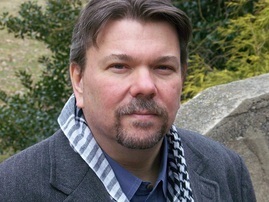 I’m always on the lookout for outstanding crime fiction, especially contemporary stories in the great noir tradition. A few years ago, I discovered the writing of Dennis Tafoya. I started with the gritty and evocative novel, THE WOLVES OF FAIRMOUNT PARK, and realized within a few chapters that I had found a new favorite writer. I raced through his darkly terrific debut, DOPE THIEF, and then devoured stories like “Above the Imperial” (from PHILADELPHIA NOIR) and “Satan’s Kingdom” (from NEEDLE Magazine and just selected for BEST AMERICAN MYSTERY STORIES 2014, edited by Otto Penzler and Laura Lippman).
I’m always on the lookout for outstanding crime fiction, especially contemporary stories in the great noir tradition. A few years ago, I discovered the writing of Dennis Tafoya. I started with the gritty and evocative novel, THE WOLVES OF FAIRMOUNT PARK, and realized within a few chapters that I had found a new favorite writer. I raced through his darkly terrific debut, DOPE THIEF, and then devoured stories like “Above the Imperial” (from PHILADELPHIA NOIR) and “Satan’s Kingdom” (from NEEDLE Magazine and just selected for BEST AMERICAN MYSTERY STORIES 2014, edited by Otto Penzler and Laura Lippman).Now, Dennis Tafoya is back with a brand-new novel, THE POOR BOY’S GAME. In a Starred Review, “Publisher’s Weekly” said: “Tafoya delivers a gut-wrenching crime thriller as gritty and harsh as a Philadelphia winter … Tafoya does a superb job keeping the reader guessing to the surprise end.”
A student of literature, film, and creativity, Dennis is also a thoughtful and insightful teacher. I was fortunate to take a writing class Dennis taught with members of the Philadelphia Liars Club and I really connected with his teaching style and the writing examples he used. Generous and encouraging to fellow writers, he helped me discover Wells Tower and THE FRIENDS OF EDDIE COYLE, and even connected me with one of the editors I used for my own debut novel.
An exquisite writer and an all-around great guy, Dennis Tafoya stops by the blog today for a fascinating discussion about the creative life — and I couldn’t be more thrilled.
Hey, Dennis, thanks for being here. Tell us, when did you know you wanted to be a writer? When did you know you were one?
I’ve been writing since I was a kid. I started writing horror and science fiction inspired by movies and TV shows and the short stories I loved when I first started reading, by guys like Ray Bradbury and Robert Bloch. There were a lot of monsters, a lot of dinosaurs lurking in remote canyons in the desert. Demons that passed through portals or holes from other dimensions. When you’re a certain kind of kid there’s a lot of cataclysmic stuff in your head trying to get out.
I don’t think I accepted that I was a real writer until I was walking from Penn Station to the Flatiron Building to meet my editor for the first time. Before I had an agent and contract I think writing was something I didn’t let myself consider a serious aspiration. It was a desire I kept hidden for all the reasons we hide things that really matter to us – fear of failure, fear of ridicule for wanting something that seems beyond the normal possibilities of a life defined by work and family and a high school diploma.
What creative work most recently inspired you?
I’m constantly looking for cool stuff to light up the creative parts of my brain. I love poetry and will sit and read the Writer’s Almanac for hours for the daily poems. There’s a poem that I stumbled on in an issue of Poetry by Mary Szybist that I can’t stop thinking about called “On Wanting to Tell [ ] about a Girl Eating Fish Eyes.” I think it’s about the irreducibility of some experiences, like the death in the title. The narrator asks the girl what the eyes taste like, and she says, ‘they taste like eyes.’ Some things aren’t like other things. Death isn’t like anything else. If I knew Mary I’d love to ask her. But even if I’m getting the poem wrong, it’s beautiful and dreamlike and startling, which describes all the stuff I really love and (most importantly) that I can feel myself learning from as I read. From Annie Proulx’s Western stories to Megan Abbott’s The End of Everything or Denis Johnson’s Train Dreams. It’s not just that I love those stories, it’s that their dreamlike quality almost overwhelms the narrative in the way that our obsessive thoughts, our endless attempt to understand our experiences can overwhelm our daily lives and obscure reality.
Have you ever abandoned a creative project?
I start and abandon work constantly, but I don’t think much actually goes to waste. If I’ve come up with anything good I’ll most likely reuse it somewhere else. Also, it can be tough to sort out abandoning from writing…really…slowly, which I also do. If when I die there are a hundred unfinished stories on my hard drive, it might be that I really did intend to go back and finish them. I need a really good idea to write the next thing in a story, and I force myself to work almost exclusively in a linear fashion; I’m not allowed to jump around in a story because I know from experience that I’ll end up with a bunch of scenes that don’t mean anything because they lack connective tissue. A sack of bones instead of a living, breathing thing.
The last film I enjoyed was …
Loved Blue Ruin by Jeremy Saulnier. It’s about violence and retribution, but without any of the self-righteousness or schmaltz of pictures that are usually about those things. The main character is avenging a wrong, but he has no idea what he’s doing, either in the particulars of attacking a violent felon or when trying to concoct a strategy to keep his family safe. The result is certainly horrifying, but also affecting because you can’t help but feel for this mentally-fragile guy who’s so completely out of his depth. Also really intrigued by The Rover and Under the Skin, both of which I think are more about evocative situations and imagery than compelling narrative.
What creative work might we be surprised to find on your shelf, iPod, or TiVo?
I read a lot of true crime, which I guess wouldn’t be surprising, but I also read a lot of military history and have a lot of old books about UFO conspiracies and ‘strange but true’ stuff from the fifties and sixties (including a few great old paperbacks given to me by Wallace Stroby) I have the collected books of Charles Fort and a copy of They Knew Too Much About UFOs by the huckster Gray Barker. I recently tore through The United States of Paranoia, by Jesse Walker, which is a terrifically smart survey of American conspiracy theories going back to the Revolution. There’s a point in the sixties where all these threads of conspiracy-obsession, UFO-obsession and Illuminati-obsession get so tangled that folks like the Discordianists - who consciously promoted conspiracy myths as a kind of cultural performance art - began to believe themselves part of an actual disinformation conspiracy, and leftwing tricksters concocted a spoof of a RAND Corporation analysis that became a staple of rightwing conspiracy mongers who thought the document was real. I’d like to use all of this stuff in a book someday, but I think I’d need help from someone much brighter than I am. Maybe one of my kids will help me sort it all out.
Facebook and Twitter: friend or foe to a creative?
I think using social media is another endeavor that requires the help of smart friends. I really admire people who do it well (the brilliant Megan Abbott comes immediately to mind), but the lure of fascinating nonsense on the web can be a little like alcohol: When does a bracing shot of brandy to steady the nerves become a three-day, Lost Weekend bender? Anyone who’s gone online to check their mail and found themselves hours later looking at pictures of freakishly huge sand crabs or a fox that adopted a pit bull will know what I mean.
The internet is absolutely essential to what I do. I’m way too shy to approach people and get information I need to write, as a rule, so I make tremendous use of online forums, wikis and other sites maintained by people with a passion for esoteric bits of data. And social media as a promotion tool clearly works, when applied correctly and diligently. My friend Don Lafferty is a fantastic resource in this area, and I always feel guilty that I don’t follow his advice more than I do. I think the trick is to get to the useful stuff and get back to work, and I haven’t mastered that yet. So, as with many things, I guess I’d say watch the folks who are doing it right and take some lessons.
In addition to writing, how do you express your creativity?
I love to take photographs. I’m not very good at it, but it’s a lot of fun.
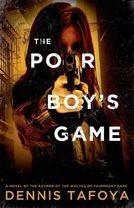 Here in the Philadelphia area, we are proud to call Dennis Tafoya one of our own. But we’re so glad the rest of the world is quickly getting to know him as well. With THE POOR’S BOY GAME, you’ll find Dennis exploring, as he tells us, “family connections and obligations, how much we’re innately ourselves and how much we’re formed by (and in opposition to) the people who raised us.” It’s time to discover the deep and dark literary world of Dennis Tafoya for yourself. You’ll find him on his website, Facebook, twitter, and in bookstores everywhere.
Here in the Philadelphia area, we are proud to call Dennis Tafoya one of our own. But we’re so glad the rest of the world is quickly getting to know him as well. With THE POOR’S BOY GAME, you’ll find Dennis exploring, as he tells us, “family connections and obligations, how much we’re innately ourselves and how much we’re formed by (and in opposition to) the people who raised us.” It’s time to discover the deep and dark literary world of Dennis Tafoya for yourself. You’ll find him on his website, Facebook, twitter, and in bookstores everywhere.
Published on July 10, 2014 06:24
July 1, 2014
BRAD MELTZER ON CREATIVITY, ANIMAL HOUSE, AND THE MOST UNDERRATED ARTISTS IN THE WORLD
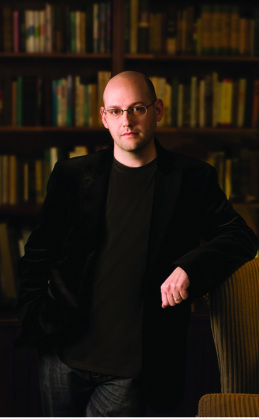 More than fifteen years ago—wow, yes, fifteen+ years ago—I went into an independent bookstore to pick up the debut novel by a guy named Brad Meltzer. I was taking a chance buying the first book by an unknown writer (in hardcover, no less), but a review I saw compared the author to Scott Turow and John Grisham and that was good enough for me. I was something of a connoisseur of legal thrillers in those days and I couldn’t wait to check out this new hotshot. Guess what--I read THE TENTH JUSTICE, loved it, and I’ve been a Brad Meltzer fanboy ever since.
More than fifteen years ago—wow, yes, fifteen+ years ago—I went into an independent bookstore to pick up the debut novel by a guy named Brad Meltzer. I was taking a chance buying the first book by an unknown writer (in hardcover, no less), but a review I saw compared the author to Scott Turow and John Grisham and that was good enough for me. I was something of a connoisseur of legal thrillers in those days and I couldn’t wait to check out this new hotshot. Guess what--I read THE TENTH JUSTICE, loved it, and I’ve been a Brad Meltzer fanboy ever since.A native of Brooklyn and Miami, a graduate of the University of Michigan and Columbia Law School, Brad Meltzer is the author of nine novels, including the #1 New York Times bestsellers THE INNER CIRCLE and THE BOOK OF FATE, as well as bestselling thrillers including DEAD EVEN, THE FIRST COUNSEL, THE MILLIONAIRES, THE ZERO GAME, THE BOOK OF LIES (another personal fave!), and THE FIFTH ASSASSIN.
Listen to this: Brad is one of the only authors to ever have books on the bestseller list for Fiction and Non-Fiction (HISTORY DECODED), Advice (HEROES FOR MY SON and HEROES FOR MY DAUGHTER), Children’s Books (I AM AMELIA EARHART and I AM ABRAHAM LINCOLN), and comic books (JUSTICE LEAGUE OF AMERICA, which won the prestigious Eisner Award).
Allow me a special shout-out here for Brad’s IDENTITY CRISIS, a controversial murder mystery involving some of my favorite superheroes.
Brad is also the host of BRAD MELTZER’S DECODED on History Channel, a show my family has loved to watch together. The Lincoln Assassination and UFO episodes were particular hits in the Cadigan household.
Brad's terrific new children’s book, I AM ROSA PARKS, was just released in June. (Perhaps you saw him talking about these great hero stories on “CBS This Morning” a couple weeks ago.) His latest thriller is THE FIFTH ASSASSIN.
As you can see, Brad is a busy, busy guy. But he always has time for fans and he’s generous to other writers. When we met last month at BookExpo America, Brad was all too willing to support a new novelist who has been with him since THE TENTH JUSTICE. I am thrilled that he took time out of his crazy schedule to visit the blog of a longtime fan (and unknown writer) as we talk about the creative life. A big thanks and welcome to Brad Meltzer.
Brad, thanks so much for being here. Let’s start with this: What creative work most recently inspired you?
I’ve been using the summer to show my younger and older sons some true film classics. THE IRON GIANT and THE TRUMAN SHOW still do it to me.
The most underrated creative (writer, musician, artist) …
Storyboard artists in film. They’re directing it with lead pencils and getting no credit at all. Viva la storyboard artist!
Which of your works comes closest to the way you heard/saw it in your head?
THE FIRST COUNSEL. It’s the only opening I ever wrote that I didn’t rewrite by the time I got to the end. It’s word for word the same.
What was the best creative advice you ever received?
"If it was easy, everyone would do it."
What creative work might we be surprised to find on your shelf, iPod, or DVR?
No one loves ANIMAL HOUSE like I love the film ANIMAL HOUSE. On my iPod, I’ve got a sudden love for the soundtrack of A STAR IS BORN, since it reminds me of my mother.
In addition to writing, how do you express your creativity?
Little notes for my kids. Tiny emails and texts and post-its. I will take them everywhere.
The most difficult thing about the life of a creative is …
That day where you’re convinced you don’t know what you’re doing. Those days come all the time. To me, if it all always goes perfectly for me, I’ll know I’m done.
Works that simultaneously made you want to write and to quit writing:
REPLAY by Ken Grimwood. THE ADVENTURES OF KAVALIER & CLAY [Robb's note: this is my top candidate for a Great American Novel]. THE FAULT IN OUR STARS. The play AVENUE Q. Any great comic book art. FOX IN SOCKS by Dr. Seuss. Watching any documentary about Jim Henson or Mr. Rogers.
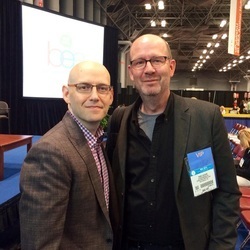 My thanks to Brad for stopping by the blog today. We had a terrific chat at BookExpo last month. A great, great guy. And particularly supportive and generous to new novelists (and longtime readers) like me.
My thanks to Brad for stopping by the blog today. We had a terrific chat at BookExpo last month. A great, great guy. And particularly supportive and generous to new novelists (and longtime readers) like me.You can find Brad at his website and he's quite active on Facebook and twitter. His wonderful children's books, like the latest--I AM ROSA PARKS--are here, along with all of his thrillers, graphic novels, advice books for our sons and daughters, and other non-fiction.
Thank you, Brad Meltzer! So great to meet you face to face after all these years.
Published on July 01, 2014 06:16
June 30, 2014
MY DAY WITH MURDERERS AND DETECTIVES
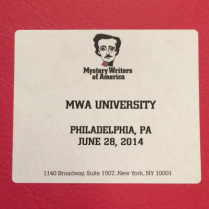 Big fun at the Mystery Writers of America University this past Saturday in Philadelphia. An excellent series of classes/lectures by top-notch instructors, held in the beautiful and historic Society Hill section of Philadelphia.
Big fun at the Mystery Writers of America University this past Saturday in Philadelphia. An excellent series of classes/lectures by top-notch instructors, held in the beautiful and historic Society Hill section of Philadelphia.Every one of the speakers, successful authors all, was engaging and inspiring. (I will say, I think the MWA should make an effort to include instructors from the host city -- there are plenty of excellent crime/mystery writers right here in the City of Brotherly Love.)
Special thanks to the instructors, every one of whom took the time to greet attendees individually and talk to us about our works-in-progress. A generous crew, full of wisdom.
The authors/instructors and their courses:
JESS LOUREY: "After the Idea"
HALLIE EPHRON: "Dramatic Structure & Plot
DANIEL STASHOWER: "Setting and Description"
REED FARREL COLEMAN: "Character"
KATHLEEN GEORGE: "Writing as Re-writing"
HANK PHILLIPPI RYAN: "The Writing Life"
If you get a chance to attend an MWA-University event like this in your area, seize the moment. There's nothing like hanging out with a bunch of murderers and investigators for a day.
Published on June 30, 2014 19:19
June 26, 2014
Q&A WITH REED FARREL COLEMAN: THE LAST MOE PRAGER MYSTERY--THE HOLLOW GIRL--IS OUT NOW!
A bittersweet time for mystery fans everywhere as crime writer Reed Farrel Coleman has released the final Moe Prager novel, THE HOLLOW GIRL -- available NOW at your favorite indie bookstore or here.
Dennis Lehane says: "In Reed Farrel Coleman's hands, the Moe Prager novels are turning into one of the great series in PI literature. These are soulful, beautifully written investigations into an American Dream that slipped through our fingers when no one was looking."
Reed was gracious enough to visit this blog a few months ago for a free-wheeling Q&A about the writing life. You can find that conversation at this link.
Grab the last Moe now -- and be sure to watch for more Reed Farrel Coleman in September as he takes over Robert B. Parker's Jesse Stone with BLIND SPOT!
PS: I'm looking forward to this Saturday when Reed and other members of the Mystery Writers of America will be leading a day of top-notch classes for fellow mystery/crime writers. Can't wait!
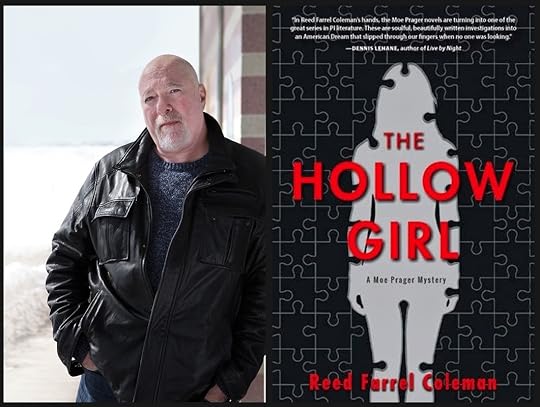
Dennis Lehane says: "In Reed Farrel Coleman's hands, the Moe Prager novels are turning into one of the great series in PI literature. These are soulful, beautifully written investigations into an American Dream that slipped through our fingers when no one was looking."
Reed was gracious enough to visit this blog a few months ago for a free-wheeling Q&A about the writing life. You can find that conversation at this link.
Grab the last Moe now -- and be sure to watch for more Reed Farrel Coleman in September as he takes over Robert B. Parker's Jesse Stone with BLIND SPOT!
PS: I'm looking forward to this Saturday when Reed and other members of the Mystery Writers of America will be leading a day of top-notch classes for fellow mystery/crime writers. Can't wait!

Published on June 26, 2014 08:52
June 17, 2014
CATCH THE FEVER AS MEGAN ABBOTT TALKS READING, WRITING, AND CREATIVE COMPULSIONS
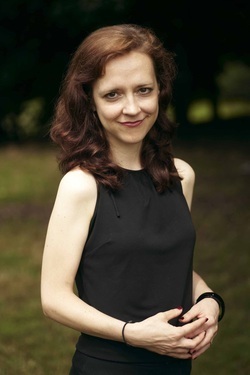 Today, June 17, is an exciting day for fans of beautifully written psychological-suspense fiction, because today brings us a new novel by the wonderful Megan Abbott.
Today, June 17, is an exciting day for fans of beautifully written psychological-suspense fiction, because today brings us a new novel by the wonderful Megan Abbott. THE FEVER, Megan’s seventh novel, is available now!
A devotee of film noir and classic noir fiction, Megan Abbott began her writing career with THE STREET WAS MINE, a non-fiction analysis of the genre. She then turned to fiction and created an unforgettable quartet of hardboiled novels — DIE A LITTLE, THE SONG IS YOU, QUEENPIN, and BURY ME DEEP — that evoke the pulp fiction of old, while telling dark tales with a fresh new voice. Indeed, Laura Lippman calls Megan “one of the most exciting and original voices of her generation.” An Edgar Award winner for Outstanding Fiction, Megan’s work has won or been nominated for all the major prizes in literary crime fiction and TIME magazine called her one of the “23 Authors We Admire.”
Megan soon brought her noir sensibilities and considerable talent to a more contemporary setting in THE END OF EVERYTHING, a breathtaking coming-of-age thriller often cited as one of the best books of 2011. The following year, she further explored the dark world of adolescent girls, this time in the ultra-noir setting of varsity cheerleaders in DARE ME (another frequent "best book" pick).
Now Megan is back with THE FEVER, a “chilling story about guilt, family secrets, and the lethal power of desire.” Publishers Weekly called it “a gripping story fueled by the razor-sharp treachery, jealousy, hormones, and insecurities of teenage girls.” The Los Angeles Times calls THE FEVER “masterful.” And none other than my friend Jodi Picoult raves that the book is “impossible to put down.” In other words, THE FEVER is the perfect summer read -- and an excellent choice for your book clubs.
A native of Michigan, Megan Abbott is a graduate of the University of Michigan and received her Ph.D. in English and American Literature from New York University. She has taught courses on the college level and is a frequent speaker at conferences and writing workshops.
I am a longtime fan of Megan’s work and her deft use of history and true crime is a huge influence on my own writing. I finally got to meet Megan face to face a few weeks ago (and yes, she is absolutely delightful in person) and I’m beyond thrilled that Megan Abbott stopped by the blog today to answer a few questions about creativity and her writer’s life in crime.
Hi Megan. Thanks so much for being here. Let's start off with this: when did you know you wanted to be a writer? When did you know you were one?
I’ve always written and even more so, I’ve always been a compulsive reader (and I love reading best), but I never had a distinct moment when I just knew. Maybe it’s yet to come!
Who or what inspired you as a kid or teenager?
Books (classics, pulp, true-crime, Southern Gothic, you name it) and old Hollywood movies (gangster movies, screwball comedies, melodramas). And my parents, both writers and both endlessly curious people. Also: Archie comic books.
What creative work most recently inspired you?
The Maid’s Version by Daniel Woodrell and Harmony Korine’s Spring Breakers.
The most underrated creative (writer, musician, artist) is …
I’ll go with Woodrell again. He’s very highly rated but should be rated a thousand times more. Same with Jack Pendarvis, brilliant short-story writer, novelist, TV writer (Adventure Time), essayist.
In moments of self doubt, how do you push through?
Mostly, I don’t know what else to do. So I keep going. That, and the occasional cocktail.
Have you ever abandoned a creative project?
Countless. You can’t know until you’re in it. And sometimes you lose your way. I started my novel The End of Everything when I was twenty-three, abandoned it, and picked it up more than ten years later and finished it.
Which of your works comes closest to the way you heard/saw it in your head?
They always change, they really do. That’s part of the mystery and excitement of the process.
What was the best creative advice you ever received?
From the wonderful writer Wallace Stroby, quoting Harry Dean Stanton: “Whatever you do … is right.”
My favorite fictional character or hero is …
Raymond Chandler’s Philip Marlowe.
The next book on my reading pile is …
An advance copy of Sophie Littlefield’s The Missing Place. It looks great.
The book I really should have read by now is …
So many! Let’s go with Crime and Punishment.
Does The Great American Novel exist (yet)? If so, what is it?
There’s been so many of them: Gatsby, Beloved, American Pastoral, Invisible Man. There couldn’t be just one. America is a complicated place.
What creative work might we be surprised to find on your shelf, iPod, or TiVo?
On my DVR I have many, many episodes of The Real Housewives of Beverly Hills.
Facebook and Twitter: friend or foe to a creative?
Both.
In addition to writing, how do you express your creativity?
I’m a compulsive Instagrammer. I love taking pictures of strange and beautiful things.
The most difficult thing about the life of a creative is …
Isolation required.
For such a nice person, you seem drawn to some truly dark tales. What are some true-crime stories you find fascinating?
All of them. Many of my books are based on real-life crimes. There’s several cases that linger with me the most: Black Dahlia, Zodiac, Jeffrey MacDonald (the case immortalized in Fatal Vision). Recently, the Amanda Knox and Casey Anthony cases. But mostly it’s seeing these tales rendered in expert writerly hands, like Robert Kolker’s superior non-fiction book last year, Lost Girls.
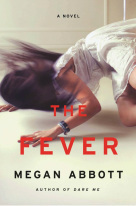 Thanks so much to Megan Abbott for stopping by the blog today!
Thanks so much to Megan Abbott for stopping by the blog today!Go catch THE FEVER and find out why THE INDEPENDENT just called Megan "the best writer of contemporary thrillers working today." And check out Megan’s other terrific work — DIE A LITTLE and THE END OF EVERYTHING are personal favorites, along with her short story “THE GIRL” (found in a tie-in collection for the L.A. NOIRE video game. Yes, Megan Abbott is everywhere. As it should be.)
For more, look for Megan on Facebook, twitter, and over at her website. Go!
Published on June 17, 2014 05:56
June 16, 2014
INDEPENDENT BOOKSTORES ARE GOOD BOOK PEOPLE!
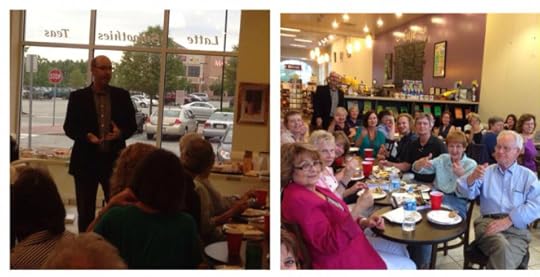 I've had a blast visiting book clubs over the past few months. Such a thrill to meet readers who really seem to enjoy my debut novel, PHOENIXVILLE RISING.
I've had a blast visiting book clubs over the past few months. Such a thrill to meet readers who really seem to enjoy my debut novel, PHOENIXVILLE RISING.Recently, I visited the wonderful store-wide book club at Towne Book Center and Cafe in Collegeville, PA, a huge supporter of PHOENIXVILLE RISING. (In fact, my novel is the bestselling regional novel in Towne's 27-year history!) We had a lively, insightful discussion of the novel, with a packed house for the book club. It's always a good thing for the writer when the store has to bring out extra chairs to accommodate the crowd!
Visit your local independent bookstore. And if you're ever near Collegeville, be sure to stop by Towne Book Center, one of the country's true indie gems. Tell them I sent you -- and let them introduce you to all the terrific books they love. Pam, Mary, Jen, Masynn, Sue, Liz and all my friends at Towne are even more accurate than an algorithm.
Published on June 16, 2014 15:23



